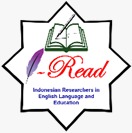“Shang Chi And the Legend of The Ten Rings": Tense and Perspective
DOI:
https://doi.org/10.22219/englie.v5i1.30956Keywords:
Tense, Aspect, Movie Script, Shang Chi and The Legend of The Ten RingsAbstract
Due to English's global significance, it indirectly affects Indonesia's education system. In this area of study, most scholarly publications speak English. All Indonesian nationals are required by law to take English classes. Many students have trouble understanding the grammatical rules of English because they are so different from those of their native language, Indonesian. The most important distinctions are those of tense and aspect. Many students struggle with grammar because of this. This analysis aims to determine which tenses and aspects are used in the script for "Shang Chi and the Legend of the Ten Rings," and which are employed most often. This research makes use of content analysis and qualitative descriptive methods. Data collection made use of record-keeping. The data was examined using the Miles and Huberman dynamic model. After the data has been compiled and presented, inferences can be made. The data shows that there are nine distinct permutations of tense and aspect. There are 33 current tenses, 37 past tenses, 6 future tenses, 35 progressive tenses, 3 past progressive tenses, 3 perfect tenses, 1 perfect tenses, 2 future perfect tenses, and 2 present perfect tenses. The present progressive is only represented by 35 occurrences, while the plain past tense is represented by 37. There are twelve permutations of tense and aspect, nine of which are used here. There is no distinction between past and future occurrences in the progressive tenses (future, past, and future perfect).
Downloads
References
Abdalla, A. H. (2014). Investigating the effect of Consciousness-raising techniques on learning the English tense system by EFL students. Journal of Language Teaching and Research, 5(4), 810–818. https://doi.org/10.4304/jltr.5.4.810-818
Adejare, R. A. (2022). Revisiting the description of tense in English. International Journal of English Linguistics, 12(4), 44-53. https://doi.org/10.5539/ijel.v12n4p44
Al-Quyadi, A. M. (2016). Complexity Level in the Use of Tense and Aspect as Perceived and Experienced by Arab EFL Learners. Advances in Language and Literary Studies, 7(1), 135–147. https://doi.org/10.7575/aiac.alls.v.7n.1p.135
Binnick, R. I. (2012). The Oxford Handbook of Tense and Aspect. Oxford University Press.
Bourjaily, M. (2018). Teaching without Talking (or, Houston, We Have a Tension). English Journal, 107(5), 20–26. https://doi.org/https://doi.org/10.58680/ej201829600
Braun, V., & Clarke, V. (2013). Successful Qualitative Research. SAGE.
Daloglu, A. (2020). EFL students’ beliefs about how they learn grammar best. English Language Teaching, 13(10), 158-165. https://doi.org/10.5539/elt.v13n10p158
Dewi, P. A. M., & Ariyaningsih, N. N. D. (2023) Conversational maxim violation by the main character in the Shang-Chi and The Legend of The Ten Rings movie. Lexicon, 10(1), 31-38. https://doi.org/10.22146/lexicon.v10i1.77798
Dikilitas, K., & Reynolds, K. M. (2022). Research Methods in Language Teaching and Learning. John Wiley & Sons, Ltd.
Dragomir, I.-A., & Niculescu, B.-O. (2021). Packing and unpacking grammar – towards a communicative approach to teaching language structures. Scientific Bulletin, 26(2), 121–128. https://doi.org/10.2478/bsaft-2021-0014
Fahmi Aajami, R. (2022). A cognitive framework in learning English progressive tense. International Journal of Language and Literary Studies, 4(2), 100–111. https://doi.org/10.36892/ijlls.v4i2.924
Fatemipour, H., & Hemmati, S. (2015). Impact of consciousness-raising activities on young English language learners' grammar performance. English Language Teaching, 8(9), 1-10.
Fitriani, S. (2019). A child language acquisition in Indonesian and English language: A longitudinal case study. Register Journal, 12(2), 126–156. https://doi.org/10.18326/rgt.v12i2.126-156
Gesa, F., Frigolé, N., & Suárez, M.-M. (2023). EFL grammar teaching applying the just-in-time teaching methodology: an exploratory study. language teaching. Research Quarterly, 39, 202–216. https://doi.org/10.32038/ltrq.2024.39.14
Guest, G., Namey, E. E., & Mitchell, M. L. (2013). Collecting Qualitative Data. SAGE.
Guo, L., & Wang, J. (2020). English tense teaching in junior high school based on prototype theory-taking the simple present tense as an example. Theory and Practice in Language Studies, 10(9), 1072-1077. http://dx.doi.org/10.17507/tpls.1009.09
Hassan, A. (2022). Editorial Covid19 EFL / ESL / English teaching environment and digital EFL / ESL / English learning methods guest editorial board. 12(7), 1–3.
He, X. (2015). An action research on improving non-English majors’ English writing by basic sentence pattern translation drills. English Language Teaching, 9(1), 142-147. https://doi.org/10.5539/elt.v9n1p142
Imanuel, I., & Ningsih, T. W. R. (2023). Conversational Implicature and Flouting Maxims In Shang-Chi and The Legends Of The Ten Rings Movie. Journal of Language and
Literature, 11(1), 82–99. http://dx.doi.org/10.35760/jll.2023.v11i1.8316
Khasanah, E. N. U., & Sutrisno, A. (2022). Realization of the use of the tense aspects in oral communication. International Journal of English and Applied Linguistics (IJEAL), 2(3), 411–423. http://dx.doi.org/10.47709/ijeal.v2i3.1851
Khatmah, A. (2020). English foreign language teachers’ pedagogical beliefs: Traditional teaching and language socialisation. Studies in English Language Teaching, 8(3), p101-117. https://doi.org/10.22158/selt.v8n3p101
Komara, C., & Tiarsiwi, F. (2021). Exploring Indonesian EFL learners’ perception of English learning grammar. Journal of English Language Teaching and Linguistics, 6(2), 459-470. https://doi.org/10.21462/jeltl.v6i2.564
Lee, Y. J. J. (2022). Using films in Second-Language Learning: Perspectives through the lens of transmedia and cultural learning. STEM Journal, 23(4), 1–11. https://doi.org/10.16875/stem.2022.23.4.1
Li, H. (2015). On guidelines for college English teaching and challenges for college English teachers. English Language Teaching, 9(1), 77-87. https://doi.org/10.5539/elt.v9n1p77
Lissamustika, N, Putra, A., & Arman, A. (2021). Intrinsic and extrinsic value in Erin Brockovich Movie script. ELITE: Journal of English Language and Literature, 4(1), 53–60. https://doi.org/10.33772/elite.v4i1.1145
Lorenna, M., Fitriati, S. W., & Widhiyanto, W. (2020). The comparison of lexical bundles in EFL teachers’ talk between non-native and native English teachers. English Education Journal, 10(1), 69–75. https://doi.org/10.15294/eej.v10i1.33830
Matsumoto, Y., & Dobs, A. M. (2017). Pedagogical gestures as interactional resources for teaching and learning tense and aspect in the ESL grammar classroom. Language Learning, 66(1), 1-36. https://doi.org/10.1111/lang.12181
Mezmir, E. A. (2020). Qualitative data analysis: An overview of data reduction, data display and interpretation. Research on Humanities and Social Sciences, 10(21), 15–27. https://doi.org/10.7176/rhss/10-21-02
Morato, R. A., Leitão Martins, A., & Gonçalves de Castro, G. (2020). Interview with Dr. Bernard Comrie: tense, aspect and mood. Scripta, 24(51), 540–557. https://doi.org/10.5752/p.2358-3428.2020v24n51p540-557
Musa, O. R.E., subaiah, S., & Mohammed, S. B. A. (2022). Investigating the importance of conversational implicature and violation of Maxims in daily conversations. Arab World English Journal, 13(2), 109–122. https://doi.org/10.24093/awej/vol13no2.8
Nugraeni, I. I., Rokhayati, T., & Dewi, L. E. P. (2023). Educational values in Finding Dory Movie Script and teaching speaking application. English Education and Literature Journal (E-Jou), 3(01), 67–75. https://doi.org/10.53863/ejou.v3i01.675
Nurfadilla, S., & Rizkiani, S. (2021, July 12). Adjagency pair of conversational script in storks 2016 movie. Project (Professional Journal of English Education), 4(4), 634-640. https://doi.org/10.22460/project.v4i4.
Oktaviani, A., & Rohayati, D. (2021). Movie clips as a media to teaching writing of narrative texts. Journal of English Education Program (JEEP), 8(1), 1-11. https://doi.org/10.25157/(jeep).v8i1.5227
Pak, T. K., Kiriella, D. A., Adiba, A., & Anam, S. (2023). Shang-Chi and the Legend of the Ten Rings. Directed by Destin Daniel Cretton. Marvel Studios; 2021. Journal of the American Academy of Child & Adolescent Psychiatry, 62(6), 700–701. https://doi.org/10.1016/j.jaac.2023.02.009
Pangesti, F., Prihatini, A., & Fauzan. (2023). The learning strategy for Indonesian grammar: Students’ perspective on Indonesian language for foreign speakers. Jurnal Pendidikan Dan Pengajaran, 56(2), 251–264. https://doi.org/10.23887/jpp.v56i2.45804
Prayudha, J. (2023). Students’ problems in implementing technology integrated in ELT classroom. Journal of English Education Program, 4(2), 125-137. https://doi.org/10.26418/jeep.v4i2.64583
Rahayu, E. L. (2020). Identifying EFL learners’ uptakes in response to corrective feedback. English Learning Innovation, 1(1), 36-43. https://doi.org/10.22219/englie.v1i1.13164
Rakhmyta, Y. A., & Maulidiyah, A. (2021). Students’ difficulties in solving higher-order thinking skills (HOTS) reading comprehension section at SMA 1 Takengon. Jurnal As-Salam, 5(2), 153–163. https://doi.org/10.37249/assalam.v5i2.313
Rosyidah, R. H. (2020). The violation of cooperative principle in conversational of presidential debate Indonesia 2019. English Learning Innovation, 1(1), 44-53. https://doi.org/10.22219/englie.v1i1.13165
Rusmiati, R. (2022). Narrative paragraph composition: A description of EFL learners’ proficiency in using past tense. Jurnal Visi Ilmu Pendidikan, 14(1), 20–27. https://doi.org/10.26418/jvip.v14i1.46067
Shabani, K., & Ghasem Dizani, E. (2015). Teacher feedback and the acquisition of simple past tense: A case of EFL learners. Journal of Studies in Education, 5(3), 57-74. https://doi.org/10.5296/jse.v5i3.7771
Siagiyanto, B. E., Kusumawati, F. P., M.Pd., R., & Aultya, A. S. (2023). Technique of translation in “Shang-Chi And The Legend Of The Ten Rings”film. Journal of English Education and Enterpreneurship (JEEP), 3(1), 31–38. https://doi.org/10.24127/jeep.v3i1.3233
Tilahun, S., Simegn, B., & Emiru, Z. (2022). Using grammar consciousness-raising tasks to enhance students’ narrative tenses competence. Cogent Education, 9(1)., 1-20. https://doi.org/10.1080/2331186x.2022.2107471
Tomy, P. M. S., Baisel, A., & M, V. (2022). Movie reviewing - A prospective incidental learning approach in English language acquisition. Studies in Media and Communication, 10(2), 99-104. https://doi.org/10.11114/smc.v10i2.5597
Torrengo, G. (2017). Perspectival tenses and dynamic tenses. Erkenntnis, 83(5), 1045–1061. https://doi.org/10.1007/s10670-017-9928-9
Wahid, M., & Afkar, R. (2023). Implicature of Paper Town Script by John Green’s movie. JL3T (Journal of Linguistics, Literature and Language Teaching), 9(1), 34–42. https://doi.org/10.32505/jl3t.v9i1.6083
Wu, J. (2022). On relevance theory’s explicature/implicature and Grice’s ‘What Is Said’/Implicature. Journal of Linguistics and Communication Studies, 1(1), 13–16. https://doi.org/10.56397/jlcs.2022.11.03
Xu, M., & Storr, G. (2015). Learning the concept of researcher as instrument in qualitative research. The Qualitative Report, 17(21), 1-18. https://doi.org/10.46743/2160-3715/2012.1768
Yamazaki, K. (2019). Future of technology in language teaching and learning. Technology in Language Teaching and Learning, 1(1), 1–2. https://doi.org/10.29140/tltl.v1n1.153
Yanuar, I. D. (2023). The acquisition of English adjective placement on the early acquisition of bilingual Indonesian language - English Child. Journal of English Language and Culture, 14(1), 16-29, https://doi.org/10.30813/jelc.v14i1.4505
Zheng, H., Learning, E. A., Movies, E., & Course, E. A. (2023). English movie autonomous learning to improve students’ English literacy from the perspective of STEAM. (2023). Lecture Notes on Language and Literature, 6(10), 40-46. https://doi.org/10.23977/langl.2023.061006
Downloads
Published
How to Cite
Issue
Section
License
Copyright (c) 2024 Rakhmyta et al.

This work is licensed under a Creative Commons Attribution-ShareAlike 4.0 International License.
Authors who publish with English Learning Innovation (englie) agree to the following terms:
- For all articles published in English Learning Innovation (englie), copyright is retained by the authors. Authors give permission to the publisher to announce the work with conditions. When the manuscript is accepted for publication, the authors agree to automatic transfer of the publishing right to the publisher.
- Authors retain copyright and grant the journal right of first publication with the work simultaneously licensed under a Creative Commons Attribution-ShareAlike 4.0 International License that allows others to share the work with an acknowledgement of the work's authorship and initial publication in this journal.
- Authors are able to enter into separate, additional contractual arrangements for the non-exclusive distribution of the journal's published version of the work (e.g., post it to an institutional repository or publish it in a book), with an acknowledgment of its initial publication in this journal.
- Authors are permitted and encouraged to post their work online (e.g., in institutional repositories or on their website) prior to and during the submission process, as it can lead to productive exchanges, as well as earlier and greater citation of published work (See The Effect of Open Access).
This work is licensed under a Creative Commons Attribution-ShareAlike 4.0 International License.
















1.png)












